#Web Authentication API
Explore tagged Tumblr posts
Text
#CodeIgniter App#Web Application Development#Backend Development#REST API with CodeIgniter#PHP MVC#CRUD Operations#CodeIgniter Authentication#CodeIgniter Form Validation
0 notes
Text
Django REST Framework: Authentication and Permissions
Secure Your Django API: Authentication and Permissions with DRF
Introduction Django REST Framework (DRF) is a powerful toolkit for building Web APIs in Django. One of its key features is the ability to handle authentication and permissions, ensuring that your API endpoints are secure and accessible only to authorized users. This article will guide you through setting up authentication and permissions in DRF, including examples and…
#custom permissions#Django API security#Django JWT integration#Django REST Framework#DRF authentication#Python web development#token-based authentication
0 notes
Text
The Legal Effects of Employer Screening Without Using Criminal Record Lookup

In the modern workplace, employers must run extensive background checks on all new hires. This shields the business from possible legal repercussions while also assisting in ensuring worker safety. A Criminal Record Lookup is a vital component of background checks. We'll talk about the legal ramifications of not doing criminal record checks for hiring purposes in this blog article, as well as why it's so important for businesses to do so.
Let's first clarify what a criminal record check is. It is the procedure to obtain a person's criminal history that is accessible to the general public. Arrests, convictions, and sentences for both felonies and misdemeanors may be included in this data. Thanks to technological advancements, businesses may now obtain this data using Background Verification APIs, which improves the process' accuracy and efficiency.
Now, you might be wondering why running a criminal background check is so important. The possible legal repercussions of not doing so hold the key to the solution. Hiring someone with a criminal record exposes a firm to one of the biggest dangers, particularly if the illegal activity includes violence or fraud. The corporation may be held accountable for negligent hiring if a criminal history employee harms others or commits a crime there. A legal claim known as "negligent hiring" holds an employer accountable for the deeds of its workers if they knew or should have known about their risky inclinations.
On the other hand, running a Public Criminal Records check can also shield businesses from legal action. The employer won't be held accountable if a criminal recorded employee commits a crime outside of the workplace that has nothing to do with their duties. The criminal record check demonstrates that the business takes appropriate precautions to guarantee the security of its workers and clients.
Every company's hiring procedure has to include a criminal background check, since workplace safety and legal compliance are critical in today's society. To learn more call Authenticate at +1 833-283-7439 or visit:- www.authenticate.com!
#Background Checks for Landlords#Web API Identity Authentication#Identity Check API#Criminal Background Check#Background Check API Free
0 notes
Text
Still struggling with insomnia so I did more research for PierMesh. I want to keep the code base simple and consistent so I'm looking at using python for the one board/transceiver only setup for mobile users. The main issue here is that unless something changes we cannot use the serial connection without modifying the code significantly on a mobile device running ios/android.
I was gonna say oh well that means we use bluetooth because the http api has no authentication mechanism but since this research is about single user mode I think that's okay because you still have to login to the wifi the board provides with a key you can set via the meshtastic provided bluetooth interface.
That all said here's the plan: write a small adapter js lib to interact with the http endpoint and connect that into the existing architecture so that with some flags it will run in browser with Pyodide/web workers. I should be able to serve this right off the transceiver itself by making some firmware modifications.
So for some use cases I've figured out the single board setup but for people serving public infrastructure to multiple people they will need to wait a bit as I'll have to devise something clever for multi-user setup authentication. I have some ideas to this end but nothing elegant yet. Maybe certain nodes can provide cryptography operations hmm.
13 notes
·
View notes
Text
What are HTTP requests?
HTTP (Hypertext Transfer Protocol) requests is one of the most common ways information is communicated between clients and servers on the internet. A client will go to the server to get resources or perform an action via a HTTP request.
HTTP requests follow a standard structure:
Request line - the request line specifies what HTTP method is being used (more on that below), the endpoint (a URL/URI, a server location on the web) that the request is being sent to. And what version of HTTP is being used.
Headers - Additional information that needs passing between client and server (cookies, authentication, OS version, etc)
Message body - data to be passed as part of the request.
HTTP has set methods which can be used for requests, they're used for different purposes.
HTTP methods
GET - used to retrieve data from a server
HEAD - is similar to get but has no body, it's usually used to assess if an API is currently available.
POST - used to send information to the server to create or update a resource using information stored in the body of the HTTP request.
PUT - Updates or creates a resource. PUT requests are idempotent, the results of them stay the same no matter how many times it's called.
DELETE - used to delete a resource from a server.
PATCH - used to update information on the server with a partial modification. E.g. updating only the title of an article.
TRACE - used as a loop back test, usually used for debugging and diagnostics of APIs
CONNECT - creates a tunnel connection to a server specified by the URL provider.
5 notes
·
View notes
Text
Prevent HTTP Parameter Pollution in Laravel with Secure Coding
Understanding HTTP Parameter Pollution in Laravel
HTTP Parameter Pollution (HPP) is a web security vulnerability that occurs when an attacker manipulates multiple HTTP parameters with the same name to bypass security controls, exploit application logic, or perform malicious actions. Laravel, like many PHP frameworks, processes input parameters in a way that can be exploited if not handled correctly.

In this blog, we’ll explore how HPP works, how it affects Laravel applications, and how to secure your web application with practical examples.
How HTTP Parameter Pollution Works
HPP occurs when an application receives multiple parameters with the same name in an HTTP request. Depending on how the backend processes them, unexpected behavior can occur.
Example of HTTP Request with HPP:
GET /search?category=electronics&category=books HTTP/1.1 Host: example.com
Different frameworks handle duplicate parameters differently:
PHP (Laravel): Takes the last occurrence (category=books) unless explicitly handled as an array.
Express.js (Node.js): Stores multiple values as an array.
ASP.NET: Might take the first occurrence (category=electronics).
If the application isn’t designed to handle duplicate parameters, attackers can manipulate input data, bypass security checks, or exploit business logic flaws.
Impact of HTTP Parameter Pollution on Laravel Apps
HPP vulnerabilities can lead to:
✅ Security Bypasses: Attackers can override security parameters, such as authentication tokens or access controls. ✅ Business Logic Manipulation: Altering shopping cart data, search filters, or API inputs. ✅ WAF Evasion: Some Web Application Firewalls (WAFs) may fail to detect malicious input when parameters are duplicated.
How Laravel Handles HTTP Parameters
Laravel processes query string parameters using the request() helper or Input facade. Consider this example:
use Illuminate\Http\Request; Route::get('/search', function (Request $request) { return $request->input('category'); });
If accessed via:
GET /search?category=electronics&category=books
Laravel would return only the last parameter, category=books, unless explicitly handled as an array.
Exploiting HPP in Laravel (Vulnerable Example)
Imagine a Laravel-based authentication system that verifies user roles via query parameters:
Route::get('/dashboard', function (Request $request) { if ($request->input('role') === 'admin') { return "Welcome, Admin!"; } else { return "Access Denied!"; } });
An attacker could manipulate the request like this:
GET /dashboard?role=user&role=admin
If Laravel processes only the last parameter, the attacker gains admin access.
Mitigating HTTP Parameter Pollution in Laravel
1. Validate Incoming Requests Properly
Laravel provides request validation that can enforce strict input handling:
use Illuminate\Http\Request; use Illuminate\Support\Facades\Validator; Route::get('/dashboard', function (Request $request) { $validator = Validator::make($request->all(), [ 'role' => 'required|string|in:user,admin' ]); if ($validator->fails()) { return "Invalid Role!"; } return $request->input('role') === 'admin' ? "Welcome, Admin!" : "Access Denied!"; });
2. Use Laravel’s Input Array Handling
Explicitly retrieve parameters as an array using:
$categories = request()->input('category', []);
Then process them safely:
Route::get('/search', function (Request $request) { $categories = $request->input('category', []); if (is_array($categories)) { return "Selected categories: " . implode(', ', $categories); } return "Invalid input!"; });
3. Encode Query Parameters Properly
Use Laravel’s built-in security functions such as:
e($request->input('category'));
or
htmlspecialchars($request->input('category'), ENT_QUOTES, 'UTF-8');
4. Use Middleware to Filter Requests
Create middleware to sanitize HTTP parameters:
namespace App\Http\Middleware; use Closure; use Illuminate\Http\Request; class SanitizeInputMiddleware { public function handle(Request $request, Closure $next) { $input = $request->all(); foreach ($input as $key => $value) { if (is_array($value)) { $input[$key] = array_unique($value); } } $request->replace($input); return $next($request); } }
Then, register it in Kernel.php:
protected $middleware = [ \App\Http\Middleware\SanitizeInputMiddleware::class, ];
Testing Your Laravel Application for HPP Vulnerabilities
To ensure your Laravel app is protected, scan your website using our free Website Security Scanner.

Screenshot of the free tools webpage where you can access security assessment tools.
You can also check the website vulnerability assessment report generated by our tool to check Website Vulnerability:

An Example of a vulnerability assessment report generated with our free tool, providing insights into possible vulnerabilities.
Conclusion
HTTP Parameter Pollution can be a critical vulnerability if left unchecked in Laravel applications. By implementing proper validation, input handling, middleware sanitation, and secure encoding, you can safeguard your web applications from potential exploits.
🔍 Protect your website now! Use our free tool for a quick website security test and ensure your site is safe from security threats.
For more cybersecurity updates, stay tuned to Pentest Testing Corp. Blog! 🚀
3 notes
·
View notes
Text
Startups need agile, scalable, and secure solutions to thrive in today’s competitive landscape. Laravel, with its robust framework, empowers businesses to build dynamic and secure web applications while scaling effortlessly. Its powerful features like Eloquent ORM, built-in security, and seamless API integration make it the ultimate choice for fast-paced growth.
Laravel offers startups a perfect balance of speed, scalability, and security. Its elegant syntax, built-in authentication, and exceptional performance optimization help businesses achieve quick deployment without compromising quality. Whether you're building a new platform or expanding an existing one, Laravel ensures your growth journey is seamless and secure.
3 notes
·
View notes
Text
What is Argo CD? And When Was Argo CD Established?

What Is Argo CD?
Argo CD is declarative Kubernetes GitOps continuous delivery.
In DevOps, ArgoCD is a Continuous Delivery (CD) technology that has become well-liked for delivering applications to Kubernetes. It is based on the GitOps deployment methodology.
When was Argo CD Established?
Argo CD was created at Intuit and made publicly available following Applatix’s 2018 acquisition by Intuit. The founding developers of Applatix, Hong Wang, Jesse Suen, and Alexander Matyushentsev, made the Argo project open-source in 2017.
Why Argo CD?
Declarative and version-controlled application definitions, configurations, and environments are ideal. Automated, auditable, and easily comprehensible application deployment and lifecycle management are essential.
Getting Started
Quick Start
kubectl create namespace argocd kubectl apply -n argocd -f https://raw.githubusercontent.com/argoproj/argo-cd/stable/manifests/install.yaml
For some features, more user-friendly documentation is offered. Refer to the upgrade guide if you want to upgrade your Argo CD. Those interested in creating third-party connectors can access developer-oriented resources.
How it works
Argo CD defines the intended application state by employing Git repositories as the source of truth, in accordance with the GitOps pattern. There are various approaches to specify Kubernetes manifests:
Applications for Customization
Helm charts
JSONNET files
Simple YAML/JSON manifest directory
Any custom configuration management tool that is set up as a plugin
The deployment of the intended application states in the designated target settings is automated by Argo CD. Deployments of applications can monitor changes to branches, tags, or pinned to a particular manifest version at a Git commit.
Architecture
The implementation of Argo CD is a Kubernetes controller that continually observes active apps and contrasts their present, live state with the target state (as defined in the Git repository). Out Of Sync is the term used to describe a deployed application whose live state differs from the target state. In addition to reporting and visualizing the differences, Argo CD offers the ability to manually or automatically sync the current state back to the intended goal state. The designated target environments can automatically apply and reflect any changes made to the intended target state in the Git repository.
Components
API Server
The Web UI, CLI, and CI/CD systems use the API, which is exposed by the gRPC/REST server. Its duties include the following:
Status reporting and application management
Launching application functions (such as rollback, sync, and user-defined actions)
Cluster credential management and repository (k8s secrets)
RBAC enforcement
Authentication, and auth delegation to outside identity providers
Git webhook event listener/forwarder
Repository Server
An internal service called the repository server keeps a local cache of the Git repository containing the application manifests. When given the following inputs, it is in charge of creating and returning the Kubernetes manifests:
URL of the repository
Revision (tag, branch, commit)
Path of the application
Template-specific configurations: helm values.yaml, parameters
A Kubernetes controller known as the application controller keeps an eye on all active apps and contrasts their actual, live state with the intended target state as defined in the repository. When it identifies an Out Of Sync application state, it may take remedial action. It is in charge of calling any user-specified hooks for lifecycle events (Sync, PostSync, and PreSync).
Features
Applications are automatically deployed to designated target environments.
Multiple configuration management/templating tools (Kustomize, Helm, Jsonnet, and plain-YAML) are supported.
Capacity to oversee and implement across several clusters
Integration of SSO (OIDC, OAuth2, LDAP, SAML 2.0, Microsoft, LinkedIn, GitHub, GitLab)
RBAC and multi-tenancy authorization policies
Rollback/Roll-anywhere to any Git repository-committed application configuration
Analysis of the application resources’ health state
Automated visualization and detection of configuration drift
Applications can be synced manually or automatically to their desired state.
Web user interface that shows program activity in real time
CLI for CI integration and automation
Integration of webhooks (GitHub, BitBucket, GitLab)
Tokens of access for automation
Hooks for PreSync, Sync, and PostSync to facilitate intricate application rollouts (such as canary and blue/green upgrades)
Application event and API call audit trails
Prometheus measurements
To override helm parameters in Git, use parameter overrides.
Read more on Govindhtech.com
#ArgoCD#CD#GitOps#API#Kubernetes#Git#Argoproject#News#Technews#Technology#Technologynews#Technologytrends#govindhtech
2 notes
·
View notes
Text
Building a RESTful API with Django REST Framework
Learn how to build a RESTful API with Django REST Framework. This guide covers setup, models, serializers, views, authentication, and best practices for creating efficient APIs
Introduction Django REST Framework (DRF) is a powerful and flexible toolkit for building Web APIs in Django. It simplifies the process of creating RESTful APIs and provides tools for serialization, authentication, and view handling. This guide will walk you through building a RESTful API with DRF, covering everything from setting up the project to creating endpoints and handling…
#API development#authentication#best practices#Django#Django REST Framework#Python#RESTful API#serialization#web development
0 notes
Text

Thousands of Corporate Secrets Were Exposed, and This Researcher Uncovered Them All 🔍🔓
Bill Demirkapi, a freelance security researcher, has discovered a significant amount of corporate secrets left exposed online, revealing major security risks ⚠️. Since 2021, Demirkapi has been employing creative techniques to sift through vast data sources, uncovering developer secrets like passwords, API keys, and authentication tokens that could be exploited by cybercriminals 💻🔑. At the Defcon security conference, he presented his findings, which included over 15,000 developer secrets embedded in software, providing access to sensitive systems such as Nebraska’s Supreme Court and Stanford University’s Slack channels 🏛️📊.
Demirkapi’s investigation also uncovered a common problem with dangling subdomains, identifying 66,000 websites vulnerable to attacks like hijacking 🕵️♂️💥. High-profile websites, including one belonging to The New York Times, were among those at risk 📈📰. By leveraging unconventional datasets, Demirkapi was able to spot thousands of overlooked security flaws, demonstrating the need for innovative approaches in cybersecurity 🔍🔐.
However, fixing these vulnerabilities proved to be a difficult task. While some companies, like OpenAI, collaborated with Demirkapi to revoke exposed secrets, others, such as Amazon Web Services and GitHub, were less responsive ⚙️🔄. Demirkapi had to create alternative methods to report the exposed data effectively. His research highlights the critical need to explore large data sources for security weaknesses, suggesting that there are still many untapped resources that could help bolster cybersecurity efforts on a broader scale 🌐🔍.
#accounting#academia#b&w#astrophotography#biology#100 days of productivity#ao3#digital art#astronomy#art#breaking news#black and white#books#comics#cars#crafts#canon#doodle#bodybuilding#diy#design#drawing#education#ecommerce#entrepreneur#economy#food#fashion#football#film
2 notes
·
View notes
Text
Do You Want Some Cookies?
Doing the project-extrovert is being an interesting challenge. Since the scope of this project shrunk down a lot since the first idea, one of the main things I dropped is the use of a database, mostly to reduce any cost I would have with hosting one. So things like authentication needs to be fully client-side and/or client-stored. However, this is an application that doesn't rely on JavaScript, so how I can store in the client without it? Well, do you want some cookies?
Why Cookies
I never actually used cookies in one of my projects before, mostly because all of them used JavaScript (and a JS framework), so I could just store everything using the Web Storage API (mainly localstorage). But now, everything is server-driven, and any JavaScript that I will add to this project, is to enhance the experience, and shouldn't be necessary to use the application. So the only way to store something in the client, using the server, are Cookies.
TL;DR Of How Cookies Work
A cookie, in some sense or another, is just an HTTP Header that is sent every time the browser/client makes a request to the server. The server sends a Set-Cookie header on the first response, containing the value and optional "rules" for the cookie(s), which then the browser stores locally. After the cookie(s) is stored in the browser, on every subsequent request to the server, a Cookie header will be sent together, which then the server can read the values from.
Pretty much all websites use cookies some way or another, they're one of the first implementations of state/storage on the web, and every browser supports them pretty much. Also, fun note, because it was one of the first ways to know what user is accessing the website, it was also heavy abused by companies to track you on any website, the term "third-party cookie" comes from the fact that a cookie, without the proper rules or browser protection, can be [in summary] read from any server that the current websites calls. So things like advertising networks can set cookies on your browser to know and track your profile on the internet, without you even knowing or acknowledging. Nowadays, there are some regulations, primarily in Europe with the General Data Privacy Regulation (GDPR), that's why nowadays you always see the "We use Cookies" pop-up in websites you visit, which I beg you to actually click "Decline" or "More options" and remove any cookie labeled "Non-essential".
Small Challenges and Workarounds
But returning to the topic, using this simple standard wasn't so easy as I thought. The code itself isn't that difficult, and thankfully Go has an incredible standard library for handling HTTP requests and responses. The most difficult part was working around limitations and some security concerns.
Cookie Limitations
The main limitation that I stumbled was trying to have structured data in a cookie. JSON is pretty much the standard for storing and transferring structured data on the web, so that was my first go-to. However, as you may know, cookies can't use any of these characters: ( ) < > @ , ; : \ " / [ ] ? = { }. And well, when a JSON file looks {"like":"this"}, you can think that using JSON is pretty much impossible. Go's http.SetCookie function automatically strips " from the cookie's value, and the other characters can go in the Set-Cookie header, but can cause problems.
On my first try, I just noticed about the stripping of the " character (and not the other characters), so I needed to find a workaround. And after some thinking, I started to try implementing my own data structure format, I'm learning Go, and this could be an opportunity to also understand how Go's JSON parsing and how mostly struct tags works and try to implement something similar.
My idea was to make something similar to JSON in one way or another, and I ended up with:

Which, for reference, in JSON would be:

This format is something very easy to implement, just using strings.Split does most of the job of extracting the values and strings.Join to "encode" the values back. Yes, this isn't a "production ready" format or anything like that, but it is hacky and just a small fix for small amounts of structured data.
Go's Struct Tags
Go has an interesting and, to be honest, very clever feature called Struct Tags, which are a simple way to add metadata to Structs. They are simple strings that are added to each field and can contain key-value data:
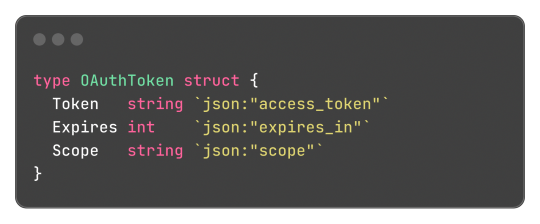
Said metadata can be used by things such the encoding/json package to transform said struct into a JSON object with the correct field names:

Without said tags, the output JSON would be:
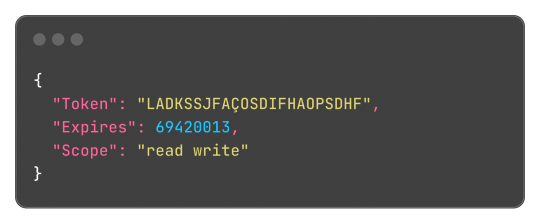
This works both for encoding and decoding the data, so the package can correctly map the JSON field "access_token" to the struct field "Token".
And well, these tokens aren't limited or some sort of special syntax, any key-value pair can be added and accessed by the reflect package, something like this:
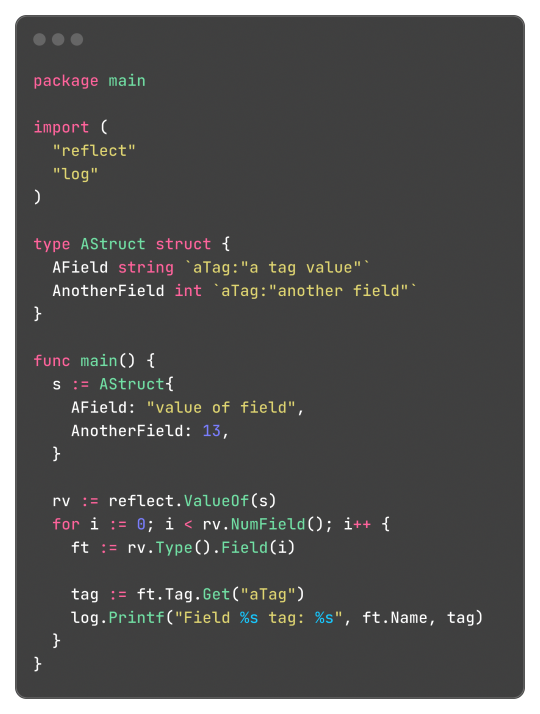

Learning this feature and the reflect package itself, empowered me to do a very simple encoding and decoding of the format where:
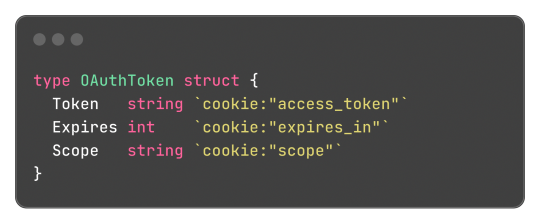
Can be transformed into:

And that's what I did, and the [basic] implementation source code just has 150 lines of code, not counting the test file to be sure it worked. It works, and now I can store structured data in cookies.
Legacy in Less Than 3 Weeks
And today, I found that I can just use url.PathEscape, and it escapes all ( ) < > @ , ; : \ " / [ ] ? = { } characters, so it can be used both in URLs and, surprise, cookie values. Not only that, but something like base64.URLEncoding would also work just fine. You live, and you learn y'know, that's what I love about engineering.
Security Concerns and Refactoring Everything
Another thing that was a limitation and mostly worry about me, is storing access tokens on cookies. A cookie by default isn't that secure, and can be easily accessed by JavaScript and browser extensions, there are ways to block and secure cookies, but even then, you can just open the developer tools of the browser and see them easily. Even though the only way to something malicious end up happening with these tokens are if the actual client end up being compromised, which means the user has bigger problems than just a social media token being leaked, it's better to try preventing these issues nonetheless (and learn something new as always).
The encryption and decryption part isn't so difficult, Go already provides packages for encryption under the crypto module. So I just implemented an encryption that cyphers a string based on a key environment variable, which I will change every month or so to improve security even more.
Doing this encryption on every endpoint would be repetitive, so adding a middleware would be a solution. I already made a small abstraction over the default Go's router (the DefaultMuxServer struct), which I'm going to be honest, wasn't the best abstraction, since it deviated a lot from Go's default HTTP package conventions. This deviation also would difficult the implementation of a generic middleware that I could use in any route or even any function that handles HTTP requests, a refactor was needed. Refactoring made me end up rewriting a lot of code and simplifying a lot of the code from the project. All routes now are structs that implement the http.Handler interface, so I can use them outside the application router and test them if needed; The router ends up being just a helper for having all routes in a struct, instead of multiple mux.HandleFunc calls in a function, and also handles adding middlewares to all routes; Middlewares end up being just a struct that can return a wrapped HandlerFunc function, which the router calls using a custom/wrapped implementation of the http.ResponseWriter interface, so middlewares can actually modify the content and headers of the response. The refactor had 1148 lines added, and 524 removed, and simplified a lot of the code.
For the encryption middleware, it encrypts all cookie values that are set in the Set-Cookie header, and decrypts any incoming cookie. Also, the encrypted result is encoded to base64, so it can safely be set in the Set-Cookie header after being cyphered.
---
And that's what I worked in around these last three days, today being the one where I actually used all this functionality and actually implemented the OAuth2 process, using an interface and a default implementation that I can easily reimplement for some special cases like Mastodon's OAuth process (since the token and OAuth application needs to be created on each instance separately). It's being interesting learning Go and trying to be more effective and implement things the way the language wants. Everything is being very simple nonetheless, just needing to align my mind with the language mostly.
It has been a while since I wrote one of these long posts, and I remembered why, it takes hours to do, but it's worth the work I would say. Unfortunately I can't write these every day, but hopefully they will become more common, so I can log better the process of working on the projects. Also, for the 2 persons that read this blog, give me some feedback! I really would like to know if there's anything I could improve in the writing, anything that ended up being confusing, or even how I could write the image description for the code snippets, I'm not sure how to make them more accessible for screen reader users.
Nevertheless, completing this project will also help to make these post, since the conversion for Markdown to Tumblr's NPF in the web editor sucks ass, and I know I can do it better.
2 notes
·
View notes
Text
Best Practices for Designing RESTful Services
RESTful services are integral to modern web applications, enabling seamless system communication via HTTP. Effective design involves clear resource naming (e.g., /users), correct use of HTTP methods (GET, POST, PUT, DELETE), and plural nouns for collections (/users). Consistent naming conventions, graceful error handling (e.g., 404), versioning (e.g., /v1/users), comprehensive documentation, robust authentication (OAuth, JWT), performance optimization (caching, pagination), scalability design (load balancing, indexing), HATEOAS for dynamic navigation, and API usage monitoring ensure reliability and security. These practices ensure APIs are robust, secure, and user-friendly.
3 notes
·
View notes
Text
Protect Your Laravel APIs: Common Vulnerabilities and Fixes
API Vulnerabilities in Laravel: What You Need to Know
As web applications evolve, securing APIs becomes a critical aspect of overall cybersecurity. Laravel, being one of the most popular PHP frameworks, provides many features to help developers create robust APIs. However, like any software, APIs in Laravel are susceptible to certain vulnerabilities that can leave your system open to attack.

In this blog post, we’ll explore common API vulnerabilities in Laravel and how you can address them, using practical coding examples. Additionally, we’ll introduce our free Website Security Scanner tool, which can help you assess and protect your web applications.
Common API Vulnerabilities in Laravel
Laravel APIs, like any other API, can suffer from common security vulnerabilities if not properly secured. Some of these vulnerabilities include:
>> SQL Injection SQL injection attacks occur when an attacker is able to manipulate an SQL query to execute arbitrary code. If a Laravel API fails to properly sanitize user inputs, this type of vulnerability can be exploited.
Example Vulnerability:
$user = DB::select("SELECT * FROM users WHERE username = '" . $request->input('username') . "'");
Solution: Laravel’s query builder automatically escapes parameters, preventing SQL injection. Use the query builder or Eloquent ORM like this:
$user = DB::table('users')->where('username', $request->input('username'))->first();
>> Cross-Site Scripting (XSS) XSS attacks happen when an attacker injects malicious scripts into web pages, which can then be executed in the browser of a user who views the page.
Example Vulnerability:
return response()->json(['message' => $request->input('message')]);
Solution: Always sanitize user input and escape any dynamic content. Laravel provides built-in XSS protection by escaping data before rendering it in views:
return response()->json(['message' => e($request->input('message'))]);
>> Improper Authentication and Authorization Without proper authentication, unauthorized users may gain access to sensitive data. Similarly, improper authorization can allow unauthorized users to perform actions they shouldn't be able to.
Example Vulnerability:
Route::post('update-profile', 'UserController@updateProfile');
Solution: Always use Laravel’s built-in authentication middleware to protect sensitive routes:
Route::middleware('auth:api')->post('update-profile', 'UserController@updateProfile');
>> Insecure API Endpoints Exposing too many endpoints or sensitive data can create a security risk. It’s important to limit access to API routes and use proper HTTP methods for each action.
Example Vulnerability:
Route::get('user-details', 'UserController@getUserDetails');
Solution: Restrict sensitive routes to authenticated users and use proper HTTP methods like GET, POST, PUT, and DELETE:
Route::middleware('auth:api')->get('user-details', 'UserController@getUserDetails');
How to Use Our Free Website Security Checker Tool
If you're unsure about the security posture of your Laravel API or any other web application, we offer a free Website Security Checker tool. This tool allows you to perform an automatic security scan on your website to detect vulnerabilities, including API security flaws.
Step 1: Visit our free Website Security Checker at https://free.pentesttesting.com. Step 2: Enter your website URL and click "Start Test". Step 3: Review the comprehensive vulnerability assessment report to identify areas that need attention.
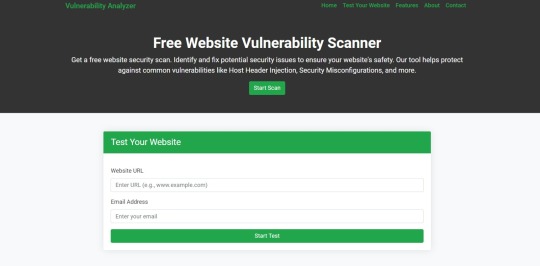
Screenshot of the free tools webpage where you can access security assessment tools.
Example Report: Vulnerability Assessment
Once the scan is completed, you'll receive a detailed report that highlights any vulnerabilities, such as SQL injection risks, XSS vulnerabilities, and issues with authentication. This will help you take immediate action to secure your API endpoints.
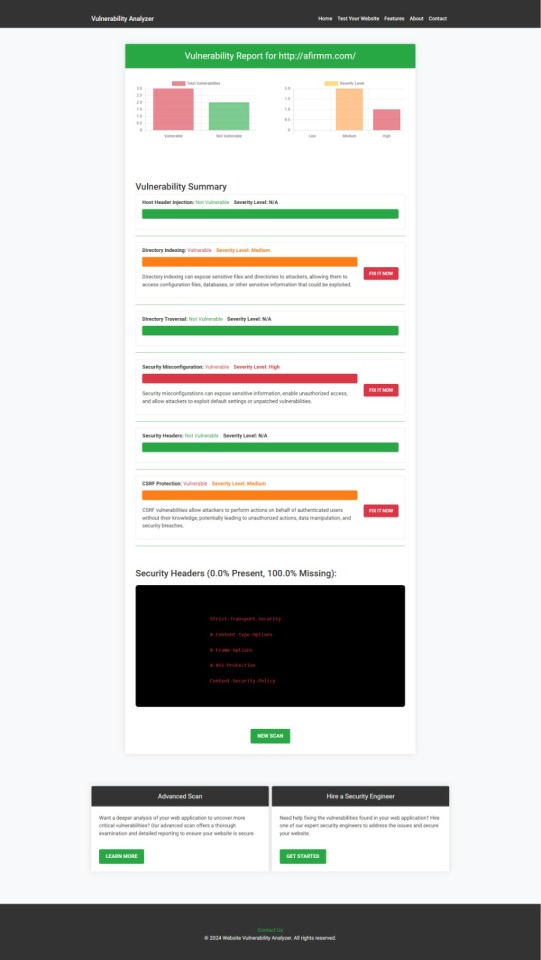
An example of a vulnerability assessment report generated with our free tool provides insights into possible vulnerabilities.
Conclusion: Strengthen Your API Security Today
API vulnerabilities in Laravel are common, but with the right precautions and coding practices, you can protect your web application. Make sure to always sanitize user input, implement strong authentication mechanisms, and use proper route protection. Additionally, take advantage of our tool to check Website vulnerability to ensure your Laravel APIs remain secure.
For more information on securing your Laravel applications try our Website Security Checker.
#cyber security#cybersecurity#data security#pentesting#security#the security breach show#laravel#php#api
2 notes
·
View notes
Text
🌟 Embracing the Future of Mobile App Development 🌟
Hey Tumblr fam! 📱✨ As we dive into 2024, the world of mobile app development is buzzing with exciting trends that are shaping the way we interact with technology. Here’s a glimpse into what’s on the horizon:
AI & Machine Learning: Apps are getting smarter, thanks to AI and ML, offering personalized experiences and predictive insights.
5G Revolution: With 5G, expect faster speeds and enhanced capabilities for apps, paving the way for immersive AR, VR, and IoT applications.
Cross-Platform Development: Tools like Flutter and React Native make it easier to develop apps that work seamlessly across different devices and platforms.
AR & VR Experiences: From virtual shopping to interactive gaming, AR and VR are transforming how users engage with apps.
Blockchain Integration: Enhancing security and transparency in mobile apps through decentralized solutions.
IoT Connectivity: Apps that connect with smart devices, offering seamless control and monitoring.
Progressive Web Apps (PWAs): Combining the best of web and mobile apps for a responsive and engaging user experience.
Enhanced Mobile Security: Biometric authentication, encryption, and secure APIs to protect user data.
Wearable Tech Integration: Apps that sync with smartwatches and fitness trackers, offering personalized health insights.
Voice-Activated Interfaces: Hands-free interaction with apps through virtual assistants like Siri and Alexa.
💡 Want to dive deeper into the world of mobile app development? Check out this insightful article on Warticles.com. It covers the top 10 key features to consider when choosing the best mobile app builder.
And if you’re thinking of building your own app, explore MageNative- Mobile App Builder on Shopify! It’s packed with features to streamline your development process.

Stay tuned for more updates and insights on technology trends. Follow for the latest in mobile app development and beyond! 📲💬
2 notes
·
View notes
Text


18.02.2024 | 16:04
I've started to work on a backend project which was actually a home task for .NET Backend Dev position with aim of developing REST API. Also started to read 'An Introduction to APIs' by Brian Cooksey'(I wish I discovered this while I was still studying, clear explanation for absolute beginners) because I figured that my C# and web skills got rusty a bit since I was using Python for a long time for both Flask projects and autonomous robot development. Application works fine right now, I tested via Postman but wanna try testing via Swagger one more time to learn what it is because the company I applied was using that. I am also planning to apply JWT authentication today and we will see how it will go.
3 notes
·
View notes
Text
20 Best Android Development Practices in 2023
Introduction:
In today's competitive market, creating high-quality Android applications requires adherence to best development practices. Android app development agencies in Vadodara (Gujarat, India) like Nivida Web Solutions Pvt. Ltd., play a crucial role in delivering exceptional applications. This article presents the 20 best Android development practices to follow in 2023, ensuring the success of your app development projects.

1. Define Clear Objectives:
Begin by defining clear objectives for your Android app development project. Identify the target audience, the app's purpose, and the specific goals you aim to achieve. This clarity will guide the development process and result in a more focused and effective application.
2. Embrace the Material Design Guidelines:
Google's Material Design guidelines provide a comprehensive set of principles and guidelines for designing visually appealing and intuitive Android applications. Adhering to these guidelines ensures consistency, enhances usability, and delivers an optimal user experience.
3. Optimize App Performance:
Performance optimization is crucial for user satisfaction. Focus on optimizing app loading times, minimizing network requests, and implementing efficient caching mechanisms. Profiling tools like Android Profiler can help identify performance bottlenecks and improve overall app responsiveness.
4. Follow a Modular Approach:
Adopting a modular approach allows for easier maintenance, scalability, and code reusability. Breaking down your app into smaller, manageable modules promotes faster development, reduces dependencies, and enhances collaboration among developers.
5. Implement Responsive UI Designs:
Designing a responsive user interface (UI) ensures that your app adapts seamlessly to various screen sizes and orientations. Utilize Android’s resources, such as ConstraintLayout, to create dynamic and adaptive UIs that provide a consistent experience across different devices.
6. Prioritize Security:
Android app security is of paramount importance. Employ secure coding practices, authenticate user inputs, encrypt sensitive data, and regularly update libraries and dependencies to protect your app against vulnerabilities and potential attacks.
7. Opt for Kotlin as the Preferred Language:
Kotlin has gained immense popularity among Android developers due to its conciseness, null safety, and enhanced interoperability with existing Java code. Embrace Kotlin as the primary programming language for your Android app development projects to leverage its modern features and developer-friendly syntax.
8. Conduct Thorough Testing:
Testing is crucial to ensure the reliability and stability of your Android applications. Employ a combination of unit testing, integration testing, and automated UI testing using frameworks like Espresso to catch bugs early and deliver a robust app to your users.
9. Optimize Battery Consumption:
Battery life is a significant concern for Android users. Optimize your app's battery consumption by minimizing background processes, reducing network requests, and implementing efficient power management techniques. Android's Battery Optimization APIs can help streamline power usage.
10. Implement Continuous Integration and Delivery (CI/CD):
Adopting CI/CD practices facilitates frequent code integration, automated testing, and seamless deployment. Tools like Jenkins and Bitrise enable developers to automate build processes, run tests, and deploy app updates efficiently, resulting in faster time-to-market and improved quality.
11. Leverage Cloud Technologies:
Integrating cloud technologies, such as cloud storage and backend services, can enhance your app's scalability, performance, and reliability. Services like Firebase offer powerful tools for authentication, database management, push notifications, and analytics.
12. Ensure Accessibility:
Make your Android app accessible to users with disabilities by adhering to accessibility guidelines. Provide alternative text for images, support screen readers, and use colour contrast appropriately to ensure inclusivity and a positive user experience for all users.
13. Optimize App Size:
Large app sizes can deter users from downloading and installing your application. Optimize your app's size by eliminating unused resources, compressing images, and utilizing Android App Bundles to deliver optimized APKs based on device configurations.
14. Implement Offline Support:
Provide offline capabilities in your app to ensure users can access essential features and content even when offline. Implement local caching, synchronize data in the background, and notify users of limited or no connectivity to deliver a seamless user experience.
15. Implement Analytics and Crash Reporting:
Integrate analytics and crash reporting tools, such as Google Analytics and Firebase Crashlytics, to gain insights into user behaviour, identify areas for improvement, and address crashes promptly. This data-driven approach helps in refining your app's performance and user engagement.
16. Keep Up with Android OS Updates:
Stay up to date with the latest Android OS updates, new APIs, and platform features. Regularly update your app to leverage new functionalities, enhance performance, and ensure compatibility with newer devices.
17. Provide Localized Versions:
Cater to a global audience by providing localized versions of your app. Translate your app's content, user interface, and notifications into different languages to expand your user base and increase user engagement.
18. Ensure App Store Optimization (ASO):
Optimize your app's visibility and discoverability in the Google Play Store by utilizing appropriate keywords, engaging app descriptions, compelling screenshots, and positive user reviews. ASO techniques can significantly impact your app's download and conversion rates.
19. Follow Privacy Regulations and Guidelines:
Adhere to privacy regulations, such as GDPR and CCPA, and ensure transparent data handling practices within your app. Obtain user consent for data collection, storage, and usage, and provide clear privacy policies to establish trust with your users.
20. Regularly Update and Maintain Your App:
Continuously monitor user feedback, track app performance metrics, and release regular updates to address bugs, introduce new features, and enhance user experience. Regular maintenance ensures that your app remains relevant, competitive, and secure.
Conclusion:
Adopting these 20 best Android development practices in 2023 will help Android app development companies in India, create exceptional applications. By focusing on objectives, embracing Material Design, optimizing performance, and following modern development approaches, your Android apps will stand out in the market, delight users, and achieve long-term success. Also by partnering with an Android App Development Company in India (Gujarat, Vadodara) you can leverage their expertise.
#Android App development company in India#Android App development agencies in India#Android App development companies in India#Android App development company in Gujarat#Android App development company in Vadodara#Android App development agencies in Vadodara#Android App development agencies in Gujarat#Android App development companies in Vadodara#Android App development companies in Gujarat
7 notes
·
View notes